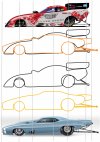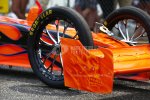mick
Nitro Member
just for the heck of it. profiles of FC and PM. quick, crude trace program, overlayed to notice profile differences.
i believe nhra limits PM to 115" wheelbase?, and FC ranges from 110" - 120"? ... assuming equal wheelbase. not trying to suggest anything,
only showing a couple of profiles superimposed.
i believe nhra limits PM to 115" wheelbase?, and FC ranges from 110" - 120"? ... assuming equal wheelbase. not trying to suggest anything,
only showing a couple of profiles superimposed.


